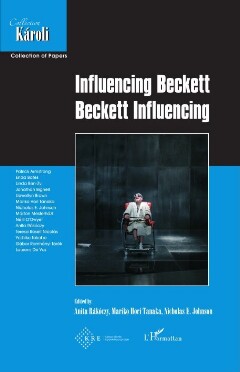Oldal 78 [78]
SAMUEL BECKETT’S LEGACIES IN CARYL CHURCHILL’S LATER PLAYS
collapse of the capitalist economy, and anti-immigration policies could be
accelerating the possible annihilation ofthe earth. Today, our lives are often
brutally imposed on by what Slavoj Zizek calls “multiple versions of external
intrusions” that could easily “destroy the symbolic texture of the subject’s
identity.”!? Those who are victimized by repeated external interruptions such
as war, terror, natural disasters, lack of food and medicine, poverty, or other
violence are physically wounded, mentally traumatized, and emotionally
hurt. Zizek calls such victims “post-traumatic’ subjects.”'? Churchill, in her
plays, warns of such an apocalyptic time as ours through her characters, who
are inflicted with trauma caused by multiple versions of external intrusions.
Ihe next section will discuss how Churchill depicts such post-traumatic
subjects in this atomic age in her later works.
CHURCHILLS POST-TRAUMATIC SUBJECTS
In her discussion of Churchill, Elin Diamond, who finds some similarities
between Churchill and Beckett, contends, “Penning her first post-Godot
play as early as 1958, she [Churchill] inherits the innovations of post¬
nuclear absurdism and takes historical and psychic fragmentation as a
given.” Churchill’s characters, trapped in traumatic conditions, reveal the
fear in the way we express the unspeakable. In an extreme case, it becomes
incoherent, illogical, and even meaningless, but through such traumatic and
schizophrenic speech can be expressed a mad dystopia, as described in Mrs
Jarrett’s monologues in Escaped Alone.
Even the dialogues that sound normal in Churchill’s recent plays, such as
Here We Go and Escaped Alone, seldom consist of full sentences and are
fragmentary. Pauses and silences, or in other words, emptiness, dominate
them. At the same time, her characters, like the tramps in Waiting for
Godot, are compelled to say something as if words or language games can
fill the silence or the void. In the first funeral party scene of Here We Go,
for example, the mourners’ superficial conversations provide the audience
with little information, from which are revealed the deceased’s last days with
2 Slavoj Zizek: Living in the End Times, London — New York, Verso, 2011, 292.
8 Ibid., 293.
M Elin Diamond: Beckett and Caryl Churchill along the Möbius Strip, in Linda Ben-Zvi —
Angela Moorjani (eds.): Beckett at 100: Revolving It All, Oxford, Oxford University, 2008,
288.
Here We Go consists of three independent scenes. Fragmentary speech is used in the first
scene, a party after a funeral where ten mourners exchange short lines. The second scene
consists of ten dead people’s monologues and a long speech by one dead person, while the
last scene is a mime by an old ill person who is repeatedly dressed, undressed and has his
nightclothes put on him by a carer, which is reminiscent of Beckett’s ...but the clouds... .
+ 77

